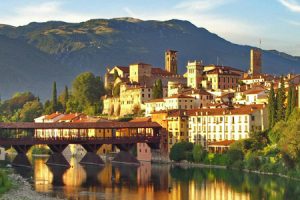 Tourists who want to leave Bassano del Grappa and head east in the direction of Treviso can take the highest road that runs along the slopes of the mountain “sacred to the homeland”. Dante wrote about the area between the fountains of Brenta and Piava – extraordinarily rich in history, art, nature, and food and wine. Little known villages that are truly a treasure trove for visitors!
Tourists who want to leave Bassano del Grappa and head east in the direction of Treviso can take the highest road that runs along the slopes of the mountain “sacred to the homeland”. Dante wrote about the area between the fountains of Brenta and Piava – extraordinarily rich in history, art, nature, and food and wine. Little known villages that are truly a treasure trove for visitors!
If you take Via Cunizza from Romano (the first village is Romano d’ Ezzelino, named after the thirteenth-century tyrant, imperial vicar), the Grappa rock massif will be to your left as it gradually slopes down into Monte Tomba and Monfenera and then meets the waters of the Piave river.
Once you reach the village of Ezzelini, where “Dante Hill” recalls a possible- but unlikely- visit from the poet himself, there will be a detour to Cadorna road. From here, it is about 45 minutes to the top of Monte Grappa. Built in 1917 during WWI, it is the most practical way to reach the summit and visit the ossuary: a majestic and disturbing testimony to the horrors of war. Among the tombs of the many Italian and foreign militias buried here, the story of the soldier Peter Pan stands out. Research revealed that the soldier was from Hungary.
 Of course, the Grappa is crossed by a myriad of paths, well-signed, which make it a paradise for hikers, bikers, and paragliding enthusiasts. Foodies will love it too and will want to sample the excellent morlacco and bastard cheeses. Strong flavors are typical of this mountain.
Of course, the Grappa is crossed by a myriad of paths, well-signed, which make it a paradise for hikers, bikers, and paragliding enthusiasts. Foodies will love it too and will want to sample the excellent morlacco and bastard cheeses. Strong flavors are typical of this mountain.
If you don’t take the Cadorna road from Romano you’ll continue straight on into the province of Treviso through the Semonzo Gate. Continue ahead and reach Borso del Grappa, a pretty village nestled in the meadows. Renowned for its handcrafted pipes, there are also delicious pastry shops.
Then continue along for another stop in the surprising hamlet of Sant’ Eulalia. This village with few very houses is guarded by the church which houses the mortuary slab of the Roman veteran Caio Vettonio (III century A.C.). Periodically the residents dress in sumptuous Roman costumes and hold a celebration in his honor. In the late spring, the Biso e Verdiso Festival is typically celebrated with excellent Verdiso wine and sugar snap peas.
If there is time for a further detour, go uphill on the left along the road that runs next to the church. Keep going even when it becomes very steep and in five minutes you’ll reach the hamlet of Cassanego. Enjoy the view from up high, a walk in the meadow, and stop at the characteristic Cassanego refuge. Historically known as Andrea Oche, you can enjoy a traditional snack of polenta, cheese, quality cold cuts, beans in sauce (a must, very typical of this area!), and locally grown vegetables.
It’s not over yet! The road continues slightly uphill towards Crespano del Grappa, set in a particularly lovely landscape.
Continue a little further, crossing the Lastego stream bridge, escorted by the mountain to the left and by gentle hills to the right, towards Possagno. Home of the great artist Canova, here you can visit the artist’s house, the museum (designed by the famous architect Carlo Scarpa) and above all, to the famous neoclassical temple that dominates the surrounding hills.
After this exciting visit to a world-famous work of art, take the way back to the Piave river. At this point, the Grappa massif silhouette will be softer and present itself as Mount Tomb (epic presence of French troops in the Great War) and then descends into the Monfenera (famous and delicious chestnuts!). The villages below are called Cavaso del Tomba and Pederobba and retain the dignified and proud aspect of villages that have known wars and emigration without ever losing their strong identity. At the Piave, leaving behind small graceful towns like Paderno del Grappa, Castelcucco and above all Asolo, another story begins. On to the noble fortress of Asolo and from there, crossing the Piave river, to the beautiful hills of Prosecco, which deserve a story all to themselves.
Photo credit: www.veneto.eu, www.comune.romano.vi.it, http://3.bp.blogspot.com, www.origineonline.it

